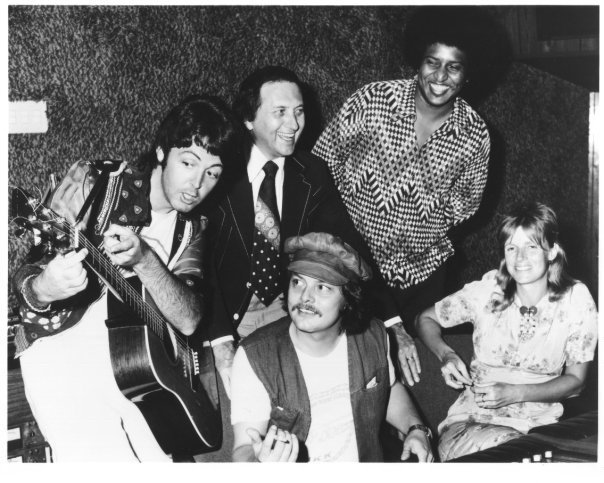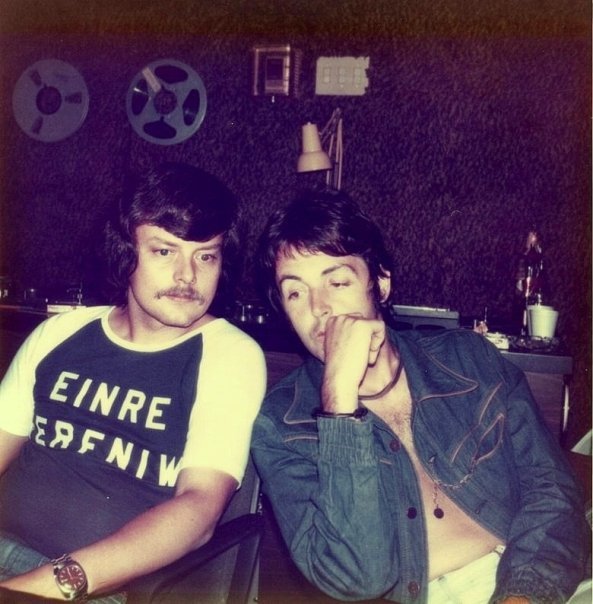From his obitury:
Ernie was a sound engineer for 23 years at Woodland Studios and SoundShop Studios, and worked closely with legends such as Paul McCartney, Dolly Parton, Neil Young, Gladys Knight, Marty Robbins, Chet Atkins, Willie Nelson,Charlie Daniels, Millie Jackson, Wilson Pickett, Joe Tex, Janie Fricke, Ronnie McDowell, Mac Davis, TG Sheppard, Gove Scrivenor, Amy Grant, Lee Greenwood, and Joan Baez.
One of his biggest joys was reconnecting with Paul McCartney in 2016, 42 years after working with him on the Junior’s Farm album at SoundShop in 1974. Ernie received a Lifetime Achievement Award from the Audio Engineering Society’s Nashville Chapter in 2014 for his life’s work and contribution to the music industry.
From The East Nashvillian, July 9, 2015:
Ernie Winfrey still recalls the night a Beatle walked through the door. It was a warm June evening in 1974, and Winfrey was in his usual place, behind the mixing console at Sound Shop studio, just off Music Row.
“Buddy Killen and I were working with [soul singer] Paul Kelly in the studio one night, and Paul and Linda McCartney just walked in the door,” Winfrey says. “They waved and sat down in front of the console. After we finished, Buddy introduced me, and Paul said, ‘It really sounds good in here.’ ”
[…] The Sound Shop’s most famous brush with rock & roll celebrity came in the summer of 1974 when McCartney brought his entire family and his band Wings to town. Lee Eastman was Killen’s attorney, as well as McCartney’s father-in-law and business manager. He asked Killen to find a country retreat near Nashville McCartney could lease for several weeks for a country vacation, sightseeing, and rehearsals for Wings’ upcoming tour of the U.S.
After failing to find a suitable location for a reasonable price, Killen talked songwriter Curly Putman into renting his 133-acre farm located just outside Lebanon. With McCartney footing the bill for a Hawaiian vacation for Putman and his wife, the former Beatle moved his entourage to Tennessee the first week of June 1974.
“They weren’t going to cut here, but Buddy was thinking, ‘Hmm, I’ve got a studio . . . ,’ and his plan worked,” Winfrey says. It only took one visit to the studio to convince McCartney to “give it a go,” but not everyone in his entourage was convinced at first, as the engineer recalls.
“Alan Crowder, his road manager, pulled me aside and very seriously asked me if we could record rock & roll,” Winfrey continues. “I don’t know what was going through his mind. I think it was the simple fact that he didn’t know if we were capable of it. I said, ‘Hell yes, I do it at every opportunity I can!’ ”
The McCartney sessions took place during the first two weeks of July. The band cut the songs “Junior’s Farm” and “Sally G,” which became a double-sided hit single for Wings that fall. They also recorded the Denny Laine composition “Send Me the Heart,” as well as “Walking in the Park with Eloise,” a Dixieland-style instrumental written by McCartney’s father that was released under the nom de plume, The Country Hams. Overdubs for several songs they had already tracked in London were also recorded, including “Hey Diddle,” “Bridge on a River Suite,” and “Wide Prairie.” Despite the thrill of working with McCartney, Winfrey says it wasn’t that different from other Sound Shop sessions, at least at first.
“Paul’s limo would come to the back of the building so they could unload their gear,” Winfrey explains. “They would come in and leisurely set up their stuff. They had a roadie-type guy helping them, but Paul always carried his own guitar.
“Buddy tried to keep it as quiet as he could, but somehow word got out. After a few days, we ended up with people outside the building trying to see Paul — front, back, everywhere. The limo driver had to pull down the driveway and all the way around to the back with people all around the car. Paul said he had learned how to handle crowds as a Beatle. He said you just have to walk slowly and smile. The important thing was not to run and scare them into a panic.”
Veteran Nashville musicians joined the band for some of the McCartney sessions. Sherrill recalls they made quite an impression on McCartney.
“He got Chet Atkins, Floyd Cramer, Lloyd Green, and some others in the studio,” Sherrill says. “Paul played them the song on the guitar once, and Chet started making out a numbers chart (the simple and efficient musical chord charting system used by Nashville session players). Paul asked him if he wanted to hear it again, but Chet said he had it and kept writing. Paul wanted to know what he was doing, and Chet started explaining the Nashville number system. Paul was just shocked. He’d never seen anything like that before, and it freaked him out, which I thought was very cool.”
Winfrey recalls McCartney was impressed with not only Nashville’s musical shorthand, but also the pure skill of the Nashville cats’ ability to adapt to challenges. “On one song, Paul was playing an ocarina, and Lloyd Green was on steel guitar,” he says. “Ocarinas are notorious for being slightly out of tune, and Lloyd had to tune his steel ever so slightly whichever way that ocarina wanted to go.” […]


July 1974 • Songs recorded during this session appear on Junior's Farm / Sally G

Notice any inaccuracies on this page? Have additional insights or ideas for new content? Or just want to share your thoughts? We value your feedback! Please use the form below to get in touch with us.